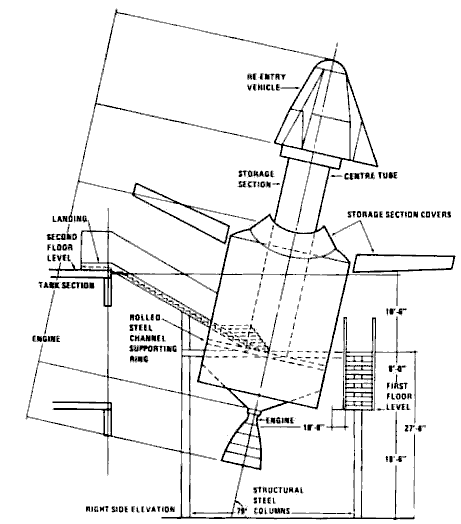
Home - Search - Browse - Alphabetic Index: 0- 1- 2- 3- 4- 5- 6- 7- 8- 9
A- B- C- D- E- F- G- H- I- J- K- L- M- N- O- P- Q- R- S- T- U- V- W- X- Y- Z
Ideal Home Station

Ideal Home Station
Ideal Home Exhibition Space Station
Credit: NASA
Status: Study 1959.
It was clearly based on the use of a Saturn S-IV spent second stage. After take-off the first stage of the Saturn I would burn out at an altitude of 60 km; the second stage would enter orbit at 400 km. Once in orbit the Space Vehicle was pointed towards the sun. Its mission was to map stellar space, to make spectroscopic observations and to obtain other astronomical data, all of which are telemetered directly to earth stations.
The crew of four men made their ascent in the nose cone (in which they also reentered the atmosphere and returned to earth). Once in orbit they moved down from the cone into the central column, blew out the fuel chamber--which was to be their working and living quarters--and set up their equipment which had been stored in the area between nose and tank. The sheathing, which covered their part of the vehicle, opened up into four petals which had sun batteries on their inner surfaces. These provided 5 kW of power to drive the electrical equipment. Inside the sheathing, telescopes, radio antennae and other gear all stood during ascent.
Working in space suits, the team assembled this equipment, transferred stores, and were soon ready to set up their space routine. During every twenty-four hours each member of the crew did approximately eight hours on duty, had eight hours for sleep and eight hours free for exercise, meals and recreation. While on duty, the crew controlled the transmission of their observations to earth and kept watch on the temperature and atmospheric conditions within the Space Vehicle.
The blue and white stripes on the outside of the vehicle were designed to absorb (white) and re-radiate (blue) the sun's heat and maintain a temperature of about 72 degrees Fahrenheit within the working quarters. The atmosphere within the vehicle was maintained from oxygen and nitrogen supplies and pressurized to simulate an environment of 3,000 m . Air breathed out by the crew (CO2) was absorbed in special containers.
Visitors who went through the exhibit realized that the crew, in a gravity-free condition, had no "floor" or "ceiling." They would be able to work equally easily in any position. The vehicle on exhibit at the Exhibition showed one of the crew at work on a telescope, in a space suit, outside the vehicle. A second crew member was inside the vehicle, in his space suit, at the ready in case of emergency; a third man was relaxing, watching earth TV; a fourth was on duty at the control console. In a gravity-free condition things remained where they were - only "restraint" straps were necessary to prevent "drifting."
When returning to earth, the crew went back to the re-entry vehicle (the nose cone) in which they made their ascent. Here they fastened themselves into special seats. They then broke the joints which attached them to the Space Vehicle and . . . aligned their vehicle so that its nose pointed in a direction to that of their orbit. A small rocket motor was then fired which reduced their speed and they began to sink into the upper atmosphere and come into the earth's gravitational pull. The re-entry vehicle was then flown earthwards, losing speed and finally, at a predetermined height, a large parachute opened automatically and the capsule floated down to the ground.
Family: Space station, Space station orbit, USA - Space Stations. Country: USA. Launch Vehicles: Saturn I. Agency: Douglas.
1959 November - .
- Douglas contacted by Daily Mail newspaper on ideas for space stations. - .
Nation: USA.
Spacecraft: Ideal Home Station.
Douglas Aircraft Co., Inc., was visited by a representative of the London Daily Mail newspaper who was visiting several companies to collect ideas for space stations. The Daily Mail held a highly promoted public exhibition each year called the 'London Daily Mail Home Show,' and wanted to have 'A Home in Space' as the theme for the 1959 show. Douglas offered to do a full design study (including mockup details) for him, and after visiting several other companies he returned and informed Douglas they had won the 'competition.' Additional Details: here....
1960 March - .
- London Daily Mail Ideal Home Exhibition Space Vehicle. - . Nation: USA. Spacecraft: Ideal Home Station. The London Daily Mail presented the Space Vehicle at its 1960 Ideal Home Exhibition, and an estimated 150 000 to 200 000 people passed through the vehicle.. Additional Details: here....
Back to top of page
Home - Search - Browse - Alphabetic Index: 0- 1- 2- 3- 4- 5- 6- 7- 8- 9
A- B- C- D- E- F- G- H- I- J- K- L- M- N- O- P- Q- R- S- T- U- V- W- X- Y- Z
© 1997-2019 Mark Wade - Contact
© / Conditions for Use